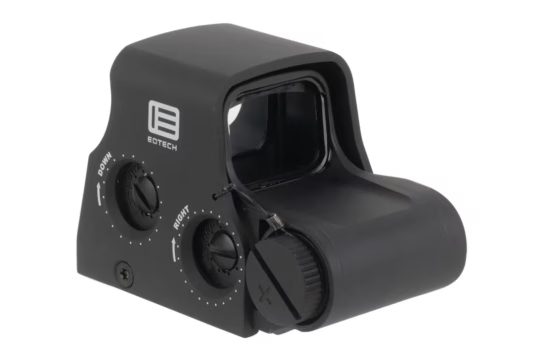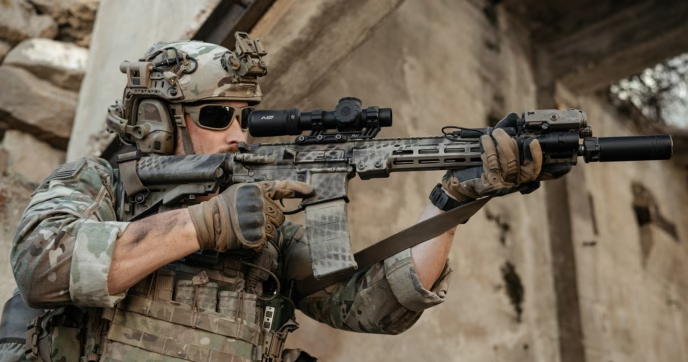Overcoming astigmatism is a common challenge faced by many enthusiasts. Although reflex sights are known for being able to enhance a rifle setup by improving target acquisition speed and overall agility, if you have astigmatism, the reticle can appear distorted, preventing you from experiencing these benefits.
However, this doesn’t mean that red dot sights are completely off the table. We’ve mentioned in earlier articles how your optic’s reticle size and pattern, as well as the type of reflex sight you choose, can seriously help with minimizing the amount of distortion you see. Still, one factor that often goes overlooked is the reticle’s color.
Despite appearing like a simple matter of aesthetics, the reticle color you choose plays a significant role in determining how well you can use your optic if you have astigmatism.
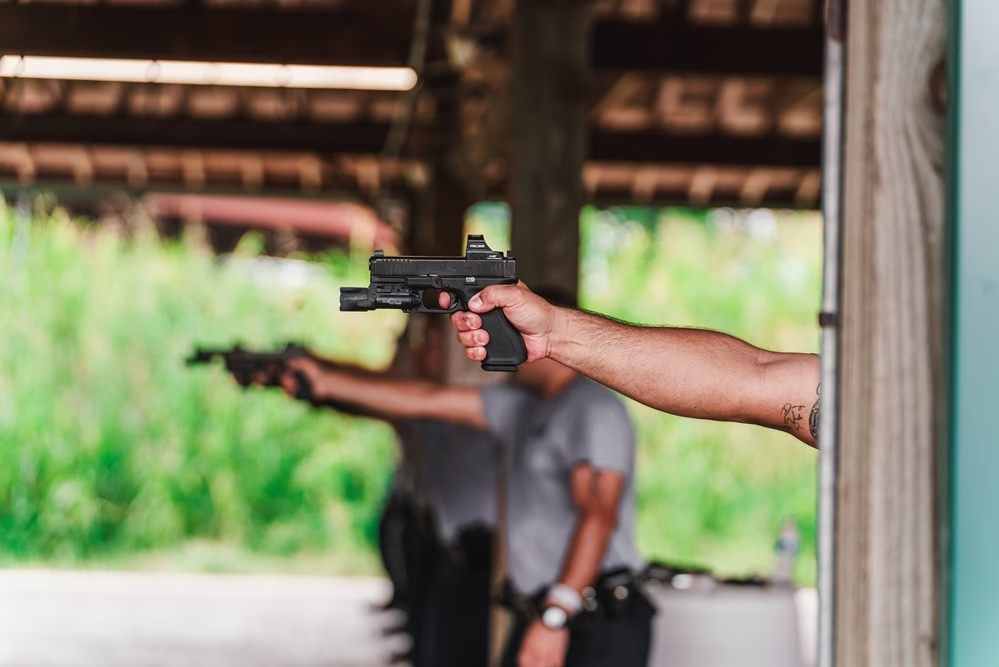
Can People with Astigmatism Use Red Dot Sights?
In short, yes, but there’s a lot to consider before buying just any reflex sight. Before getting into the intricacies of how different reticle patterns and colors can help with astigmatism, it’s important to understand what exactly the condition is, and how it affects your ability to use such optics.
We touched on this briefly above, but to put it simply, astigmatism is a vision condition that most often causes blurry or distorted vision, which is accentuated when looking at a reflex sight reticle. For instance, instead of seeing a crisp, clean center dot, your reticle might appear as if it’s blown out or smeared. In more severe instances, it can have a starburst effect, or you could see several dots rather than just one.
This can cause many issues when shooting, but it’s critical to recognize that having astigmatism doesn’t automatically render reflex sights unusable. We cover this in-depth in our guide on running a red dot with astigmatism, but by choosing the right reticle color, size, and pattern, it’s more-than-possible to use a reflex sight with astigmatism.
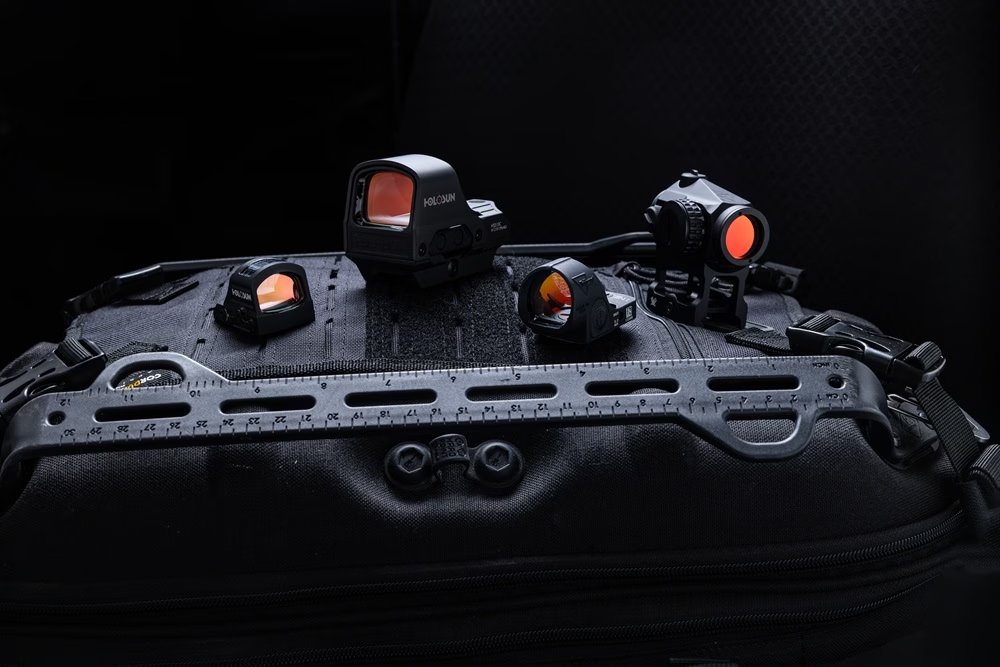
Red vs. Green Dots for Astigmatism
As we mentioned above, reticle color can greatly help with mitigating astigmatic distortion. Although red reticles are more or less the standard option, you can also opt for a green dot sight.
Green Dot Sight Pros and Cons
Green reticles have several advantages over red ones, with the primary one being their enhanced visibility. The human eye is inherently more sensitive to the green light wavelengths, making green reticles easier to pick up and see—they stand out against a wider variety of backgrounds as well, and they’re also great for use in brighter environments too. However, when it comes to astigmatic blur, green’s performance is completely dependent on your individual astigmatism. Astigmatism isn’t very consistent, and it affects everyone differently. While some enthusiasts note that green reticles are easier to use, this isn’t universally true for everyone with astigmatism.
There are also some downsides to green. One of the most prominent considerations is their power consumption. Green LEDs generally require more power than red ones, giving optics with green reticles shorter overall battery lives. It’s worth noting that green dot sight battery lives can still last upwards of 25,000 to 50,000 hours in some instances, but they don’t typically last as long as red reticle models. Additionally, since green LEDs cost more to produce, green dots usually have a slightly higher price compared to standard red dots.
Are Green Dot Sights Better for Astigmatism?
If you have astigmatism, a green reticle can definitely provide a clearer and more refined reticle picture, but no reflex sight, regardless of its reticle color, is going to be 100% free of astigmatic distortion since they use a projected reticle instead of a physical one. So, in addition to switching to a green reticle, opting for something with a larger or more complex reticle design can help to further mitigate the effects of astigmatism.
As you increase a reticle’s size, it decreases the severity of distortions brought on by astigmatism, making 3- to 4-MOA dots on full-size reflex sights and 4- to 6-MOA dots on mini-reflex sights the go-to options for many. Moreover, circle-dot reticles, chevron patterns, and other specialized reticle designs provide a similar effect.
Popular Green Dot Sight Options
Green reticles aren’t necessarily a new concept in the optic industry, but as they’ve grown in popularity, there are a lot of optics to choose from that use them. Below is a brief list to help get you started on your search:
Primary Arms Optics
Primary Arms Optics is well-known for the sheer variety of sight options they offer, ranging from variable power optics and award-winning prism scopes to reflex sights of all sizes. Among their various reflex sight models, their Classic Series 24mm and 21mm Micro Reflex Sight Gen 2 optics are each available with green reticles.
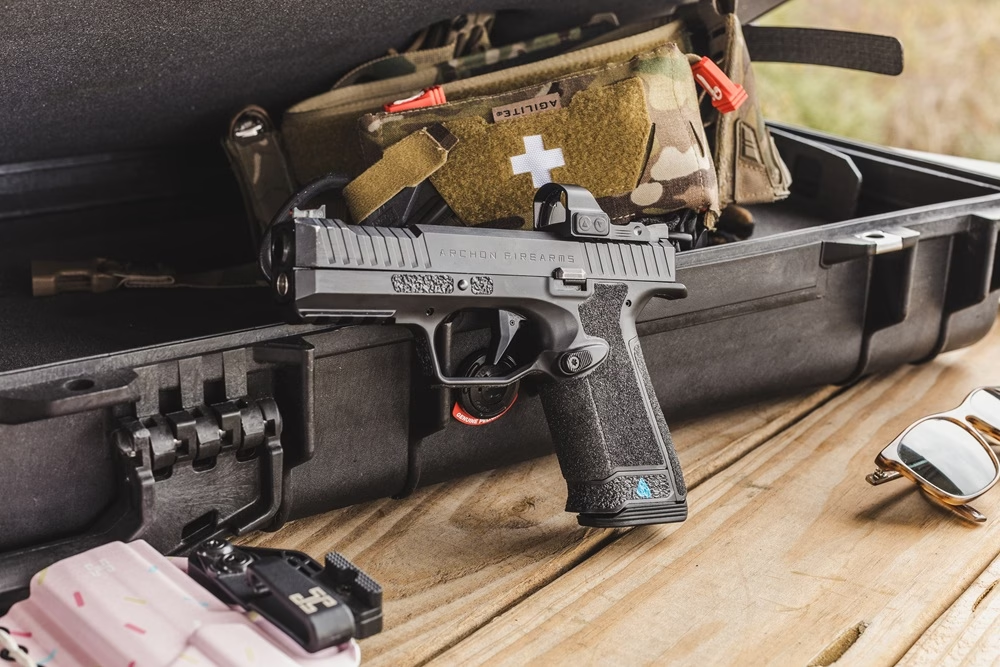
Classic Series 24mm Micro Reflex Sight
The Primary Arms Optics 24mm MRS mini-reflex sight is a great utilitarian optic fit for all budgets. Designed for use on full-size and compact pistols, they utilize the popular Trijicon RMR mounting footprint, and as their name suggests, they’re outfitted with a large 24mm lens, giving them a wide FOV and sight window. They’re constructed from durable 6061-T6 aluminum, and they’re exceptionally light, weighing less than an ounce (.98 ounces), and they’ve been optimized for concealed carry and competition.
PAO 24mm MRS mini-reflex sights are packed with features. As mentioned above, they come equipped with a 3-MOA dot reticle and have 10 brightness settings to choose from, including night vision compatible options. Powered by a CR2032 battery, they already have a long battery lifespan, but it’s further enhanced with AutoLive® motion activation, and it also has an automatic shut-off feature to maximize battery life. Both features allow this optic to have a battery life of up to 40,000 hours.
Classic Series 21mm Micro Reflex Sight
Essentially, you can view the PAO Classic Series 21mm MRS mini-reflex sight as the little brother to the previously mentioned 24mm MRS. Both optics share many of the same features and capabilities, but their core distinction is their size. Overall, the 21mm MRS mini-reflex sight is much smaller, with it being designed and optimized for use on sub-compact and micro-compact pistols. Being made from 6061-T6 aluminum, it’s one of the lighter optics on the market, weighing only .56 ounces.
It’s 21mm lens provides a wide FOV comparable to the optic’s size, giving you ample view of your reticle and target when aiming. Even further, it houses a green 3-MOA dot reticle and is powered by a CR2032 battery, just like the 24mm MRS. Likewise, it’s also equipped with AutoLive® motion activation and an automatic shutoff, giving it an equally long battery life of up to 40,000 hours.
Holosun
Holosun has garnered a significant reputation for crafting a plethora of high-quality optic models. Their lineup consists of an assortment of options designed for both pistols and long guns.
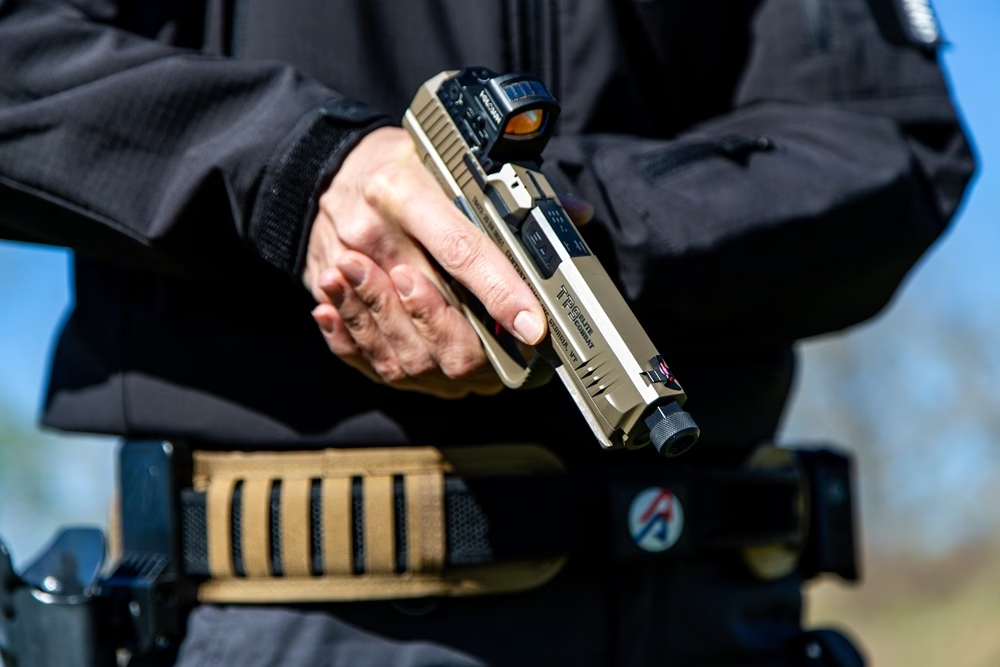
Holosun HE507C
The HE507C is one of the most popular mini-reflex sights they offer. These optics can project either a 2-MOA dot or a circle-dot reticle, and to further add to their capabilities, they come standard with a solar failsafe unit and ShakeAwake™ motion activation, which allows the battery to last upwards of 50,000 hours. Additionally, select HE507C models have been made in partnership with Primary Arms Optics, meaning there are a few Holosun ACSS® Vulcan® green reticle models too.
The ACSS Vulcan reticle system is the only one of its kind. Instead of featuring just a center dot, this version of the Vulcan reticle has an infinitely precise center chevron and a larger 250 MOA outer circle that’s only visible when your aim is off-center, guiding you back to the center dot. This is exceptionally beneficial in high-stress, dynamic scenarios like defensive, duty, and competitive shooting disciplines.
Holosun 507COMP
Designed for competitive shooting, The 507COMP is essentially a larger version of the HE507C. The Holosun COMP green has a far larger lens than the standard 507C, giving you a much wider FOV. It also comes standard with Holosun’s Competition Reticle System which can project a 2-MOA dot with either an 8-, 20-, or 32-MOA outer ring (with combinations as well). Like the 507C, the 507COMP is equipped with ShakeAwake motion activation and an automatic shut off, giving it a 50,000-hour battery life. It doesn’t come with a solar failsafe, but its long battery life makes up for this.
Holosun EPS
Last is the Holosun EPS Carry pistol green dot sight, another solid choice that uses an enclosed emitter design to better protect the emitter diode and make it more resistant to environmental hazards. Although this does give the EPS Carry a slightly narrower FOV compared to the 507C and 507COMP, it’s still an excellent choice for EDC use, as well as competitive and duty applications.
Depending on which model you look at, they can come with Holosun’s multi-reticle system or a simpler 2- or 6-MOA dot reticle. They come with the same basic features as the earlier optics, such as ShakeAwake and an automatic shutoff, but not every model comes with a solar failsafe. Like the 507COMP, the EPS carry also has a battery life of up to 50,000 hours.
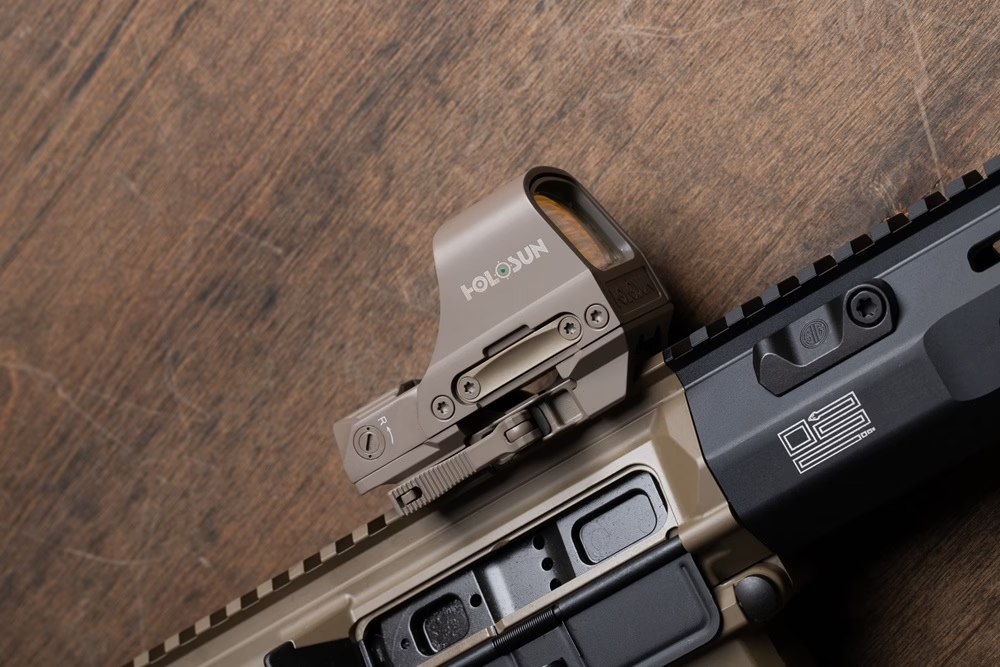
Holosun HE510C-GR
Designed for carbines like the AR-15, the Holosun HE510C-GR is one of their most popular optics. Its open-emitter design gives it an incredibly wide field of view and makes it exceptionally lightweight (4.9 ounces). Moreover, it comes standard with ShakeAwake motion activation, an automatic shutoff, and a solar failsafe unit, giving its battery a life of up to 50,000 hours. Furthermore, it has a built-in QD release and comes with a durable titanium shroud to better protect the lens and optic body. Lastly, the 510C can project either a 2-MOA dot, a 65-MOA outer circle, or both to form a circle-dot reticle image.
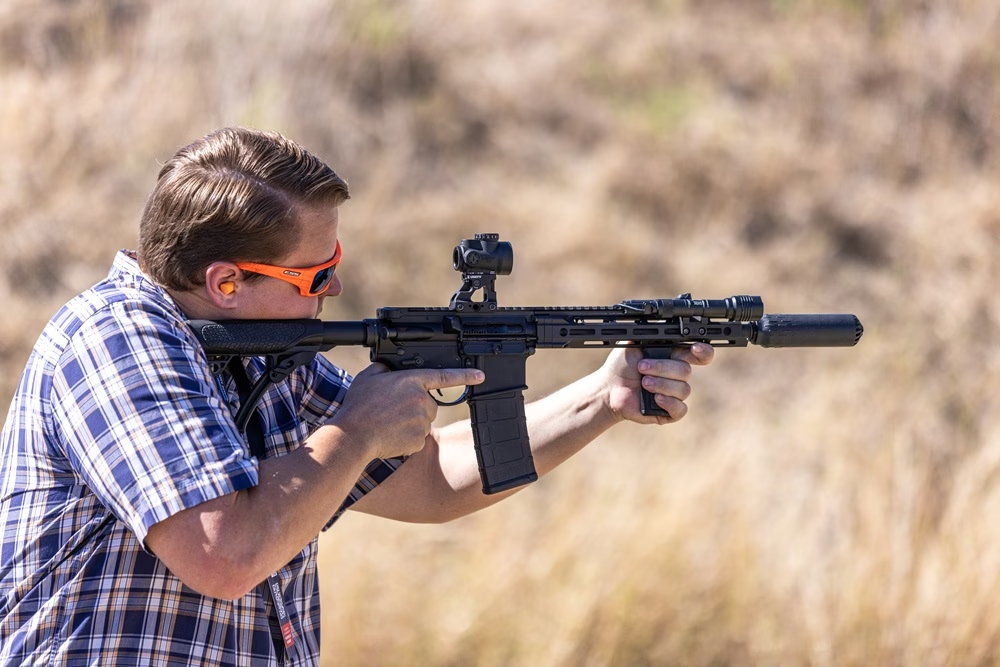
Trijicon
For decades, Trijicon has been one of the industry’s leading brands, with them having created several iconic rifle and pistol sight options. Among their offerings, their reflex sights stand out, with one of their most popular ones being the MRO.
The Trijicon MRO Green Dot Sight is designed to offer nothing short of rugged reliability and utility, making them a solid pick for all applications. By design, the MRO’s wide 25mm objective lens gives it a wide FOV, and for optimal clarity, they’re equipped with specialized multi-coated lenses. Constructed from 7075-T6 forged aluminum, it’s resistant to shock and general use, plus, it’s waterproof up to 100 feet. It’s also a lightweight option as well, weighing only 4.1 ounces without a mount.
MRO Green Dot Sights are available in either a black or FDE finish, and they can also come with varying mounts that offer different cowitness heights. Lastly, these optics use a rotary knob to adjust brightness, so they don’t come with an automatic shut-off or motion-activation feature, but they still offer up to 1 year of continuous use (on brightness setting three).
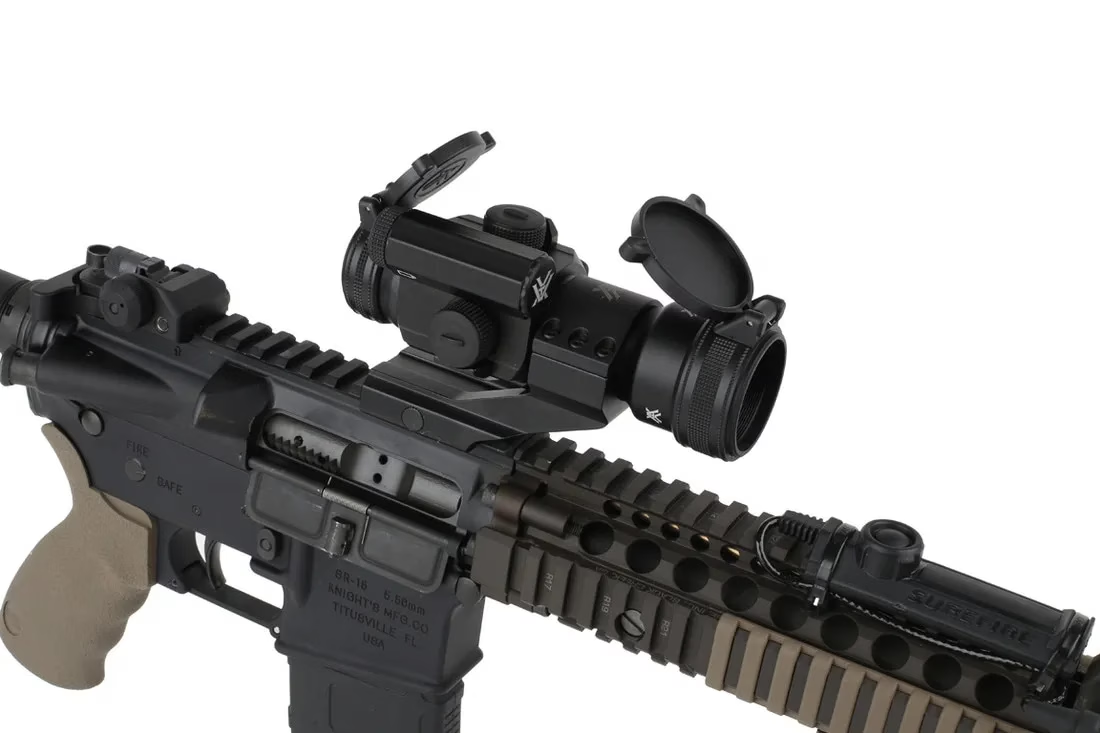
Vortex Optics
Vortex Optics, despite being best known for their variable power optics, offer multiple reflex sight models, with options like the StrikeFire II being among their most popular.
Rather than being a dedicated Vortex green dot sight, the StrikeFire II is unique in that it can project both a red and green reticle, giving you the ability to freely switch reticle colors at will. These optics come standard with a 4-MOA dot reticle, a lower 1/3 cowitness mount, and they’re compatible with other 30mm reflex sight mounts. The StrikeFire II is one of the larger optics mentioned thus far, but in spite of its size, it’s still relatively light, weighing only 7.2 ounces. Plus, they’re powered by a CR2 3V lithium battery, giving it a battery life of upwards of 80,000 hours.
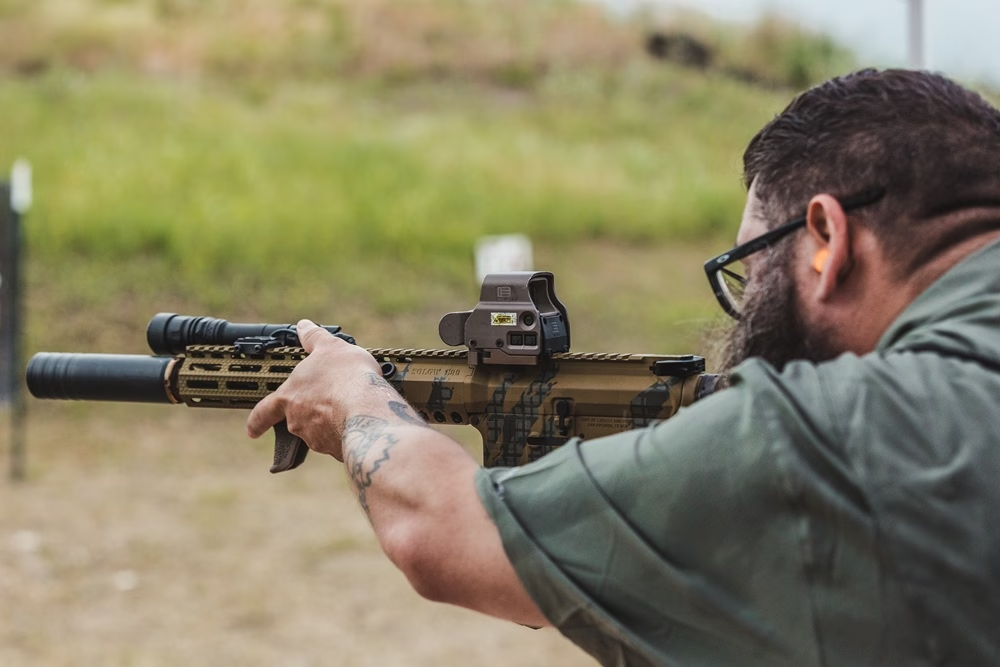
EOTech
Known for being the creator of holographic sights, EOTech offers some of the most advanced, utilitarian, and rugged holographic sight options. Although most of their optics feature red reticles, there are a couple EOTech green reticle optics available as well. Both their XPS and EXPS optic series are available with green reticles, and they offer a near identical level of performance, with their primary difference being their construction. EXPS optics come with a built-in QD mount, while XPS optics mount directly to picatinny rails. Feature-wise, they’re practically identical.
These optics are exceptionally durable—they’re designed to be resistant to impacts and harsh use in adverse conditions, and they’re water resistant to up to 10 feet. Because of their more robust design, these optics are heavier than most reflex sights, with XPS optics weighing 9 ounces, and EXPS models weighing 11.2 ounces. Regardless, both optics offer 20 daylight brightness settings, and their batteries can last up to 1,000 hours, depending on your brightness setting and environment. Additionally, being holographic sights, they offer a near-parallax-free reticle image that’s less prone to distortion, making either one a solid choice to consider.
Conclusion
Although astigmatism can negatively affect your ability to use a reflex sight, it doesn’t make using one an impossibility. While green reticles on their own won’t make distortions go away entirely, they can greatly improve the overall clarity of your reticle image, especially when using an optic with a larger dot or a complex reticle pattern.
As green dots have continued to rise in popularity, so has the number optics that use them, with there being no shortage of top-tier choices to pick from, with each of the optics mentioned above being a solid alternative to standard red dot sights. Still, even though there are a plethora of great optics to choose from, it’s important to take your needs and preferences into consideration before pulling the trigger on one. You’ll want to make sure that, in addition to its color, it has the reticle and features you want. If it checks all your boxes, it’s a viable choice.
If you’re still on the fence about using a reflex sight, we highly recommend checking out the article we highlighted above—it goes even further in-depth on the different tips and tricks for using a red dot with astigmatism, and it also covers some popular alternatives to consider if you want to run something other than a reflex sight.
